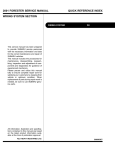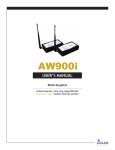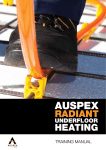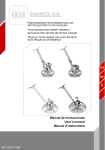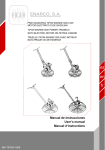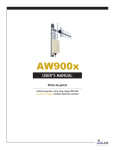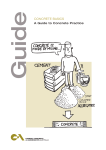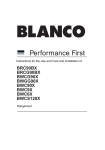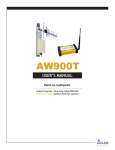Download Best Practice Placement Guide
Transcript
Strength. Performance. Passion. Best Practice Placement Guide Innovative decorative concrete Plan ahead, hire a professional, enjoy the results Thankyou for choosing our Concept™ range of architectural concrete. This Best Practice Guide aims to assist you primarily with exposed aggregate concrete projects but is also relevant to other Holcim Australia (‘Holcim’) concrete projects. This guide is written in particular for Western Australian coastal, sandy sites. It is recommended that any area to be concreted, be well watered prior to your Installer coming onsite. and architect or designer are aware of your choice. Holcim recommends the use of SL82 slab mesh in all polished or Concept™ internal ground slabs. In simple terms...a better prepared site will result in a better finished job Note that reinforcing mesh in any concrete ground slab assists in transferring loads from both expansion and contraction (due to heating and cooling) as well as direct loads placed on the concrete. It also reduces crack widths in a house slab. Vertical mechanical vibration is required for Polished Concept™ floors but should be avoided for Exposed Aggregate or Honed projects. Reinforcement Concrete has very high compressive strength, but relatively poor tensile strength. Therefore, it is essential to use steel reinforcing to give concrete additional strength in tension. Steel reinforcing also assists in the control and movement of cracks. Make sure you check with your Concept™ Installer who will be placing your concrete, that your concrete is placed in accordance with these “Best Practice” guidelines. Extra copies of this leaflet are freely available from any Holcim sales centre. Placing your Concept™ architectural concrete is mostly a straightforward task, but be aware there may be additional factors to take into consideration such as adequate preparation of the site. We encourage you to read through this leaflet and check any items with your Installer and our Holcim sales staff. Holcim strictly controls the quality of its concrete products, but be aware there are many factors that you should consider in planning any paving project. This leaflet is intended as a general guide to assist you with your Concept™ project and ensure that your exposed aggregate concrete looks great for years to come. Preparation is the key It is common practice for concrete projects to be engineer designed and at the outset you may choose to consult a structural engineer to specify and design your project. Then, the first step is to ensure the area where you will lay your Concept™ concrete has been graded and compacted. Be especially aware that areas alongside buildings, and retaining and pipe work are often poorly compacted. Poor compaction may result in settling and water action in and around these areas. Soak wells and drains can also produce settlement cracks in your Concept™ project. That is why it is always a good idea to call in a professional to check compaction for any type of paving job. Apart from issuing a compaction certificate, you’ll have peace of mind that your site will not be subject to settlement. Your Installer must use bar chairs designed to hold the steel reinforcement above the ground when placing the steel mesh. It is essential to use commercial bar chairs, as they will hold the reinforcing mesh in the upper part of the concrete, where it best assists in crack control. It is not acceptable for Installers to lift or “hook up” the reinforcing mesh. The reinforcing mesh should be a minimum 20mm from any concrete surface so it is not in contact with the atmosphere. Concrete is highly alkaline and steel will not rust in concrete, provided that it is fully encased by the concrete. To ensure the edges of concrete paving have no air holes, it is useful for the Installer to compact paving edges simply by tamping along these areas prior to floating or trowelling the surface. In honed or exposed aggregate Concept™ projects, Holcim recommends that you use SL62, or heavier, reinforcing mesh. If you are using Polished Concept™ concrete as your house slab or suspended slab, please ensure your structural engineer Cracking Be aware that cracking (although undesirable) may occur in concrete products and this in turn can affect the appearance of your Concept™ project. There are many factors which may cause cracking, but this can be minimised by strictly adhering to the Best Practice placement methods outlined in this leaflet. If you pour concrete on hot, humid or windy days, the concrete may be subject to plastic shrinkage cracking, which occurs when the concrete is still plastic or wet. Surface cracks of varying lengths appear at random over the surface of the concrete caused by excessive “bleeding” of moisture from the concrete. Protecting the concrete surface from drying out will assist in preventing this type of cracking and Holcim recommends that Installers apply aliphatic alcohol to the concrete surface after initial ‘screeding’ or ‘floating’. The aliphatic alcohol applies a thin film surface membrane to your concrete and will slow the evaporation rate and keep moisture within the concrete at optimal levels. It should be reapplied each and every time the concrete is “worked” and in accordance with the manufacturer’s data sheet. If it’s windy, erect wind barriers around the project. If possible, it is better to simply avoid pouring Concept™ concrete on days of high temperature or high wind. However, if it is critical to pour concrete on such days, it is essential to ensure that you take steps to prevent rapid drying of your Concept™ concrete. On warm to hot days, your concrete is prone to rapid drying after final placement. Normal “pond” curing is not suitable for either Polished floors or Exposed Aggregate projects. In such circumstances it may be necessary to apply a single coat of solvent-diluted acrylic sealer (sometimes referred to as same day sealer) to your finished concrete. Using a water vapour barrier (plastic or “poly”) under the concrete is essential where practical, and can help avoid such cracking. It also assists in reducing movement restraint due to friction between the concrete and the sub-grade (or soil) below your concrete. Additionally, it will also help in protecting your concrete from possible discolouration from underground water, dampness or waterlogging. An Installer who does not supply “poly” runs the risk of darker soils clinging to their boots and contaminating the concrete. Adding excess water to the mix should be strictly avoided, as this practice will alter the colour, finish and strength of your concrete. Holcim’s Concept™ is designed to be installed at a “slump” of 80-95mm and adding water onsite may increase the slump beyond this range and therefore alter the design specification of the concrete mix. Sprinkling water on the surface during or after finishing should also be avoided. Control joints As concrete loses moisture over time it shrinks. If the concrete is restrained from shrinking by such things as footings or existing walls then internal tensile forces will be created in the concrete which can cause the concrete to crack. This type of cracking can be reduced by strengthening the concrete to resist the tensile forces (by the addition of adequate reinforcement) and removal of restraints on the concrete (allowing it to move) by the use of control and isolation joints. The plastic or “poly” covering the ground also reduces these restraining forces. Control joints are purposely created planes of weakness in concrete to ensure that anticipated cracking due to shrinkage will take place at predetermined and aesthetically appropriate areas. To be effective, control joints need to be deep enough so that it is the weakest part of the surrounding concrete. surface, such as the wall of an existing building or other concrete, your Installer should create an expansion joint utilising foam joint filler (which can be purchased from Holcim South West & Great Southern Sales Centres), as pictured right. Any circular cut-out shape in your paving should also have 4 separate control joints radiating from the shape. In the case of curves or garden beds, control joints should take the shortest path from the curve to the closest wall or pier (as pictured below. Holcim recommends that all joints be cut a minimum 25% of the concrete depth. These joints may be cut by trowel and jointing tool whilst the concrete is plastic or by saw, no later than 18 hours after the concrete is laid. Saw cut joints can introduce unwanted moisture into your concrete which can later produce a milky colour on sealed concrete. Be aware that saw cut joints can allow for foreign material such as sand to deposit in the joints, which when weeds grow in this material, can cause the concrete edges to crack. Commercial coloured seals are available to cover saw cut joints and prevent these issues. Should you be laying Concept™ alongside an existing concrete project such as a kerb, please ensure that any existing control joints continue through to your newly laid concrete. Put simply, if there is a line (joint) in the kerb, make Alternatively, your Installer may supply one of several commercial jointing products. As already noted, concrete will crack if it is restrained from moving by bonding with hard surfaces such as brick walls, existing concrete surfaces, columns and plumbing fittings. It is essential to construct filled isolation joints around and along hard surfaces and Holcim recommends the use of a commercial foam joint available from your local Holcim sales and display centre. sure that line continues through your paving as it does in the photo right Try to avoid sharp triangular shapes as concrete may crack across narrow shapes. Assuming the depth of your Concept™ is 100mm, Holcim recommends that control joints be no further spaced than 2.5 metres and at an absolute maximum 3 metres. When planning your project with your Installer you should aim to achieve square rather than elongated shapes with your control joints. When laying concrete with a random pattern finish, continue to observe the normal rules relating to control joints. Remember, a joint will encourage your concrete to crack at this point, and if a joint stops in a random pattern, the concrete may crack beyond the point at which the random pattern joint stops. So it is important to utilise full-length or full-width control joints even in random pattern finishes. Control joints should run from all hard corners such as brick piers, soak well covers or the corner of a building. If there is a rectangular cut-out in your paving, such as a garden bed, control joints should run from each of the 4 corners. Additionally, if your Concept™ concrete is going to meet an existing hard It is important to plan the location of control joints prior to placing concrete as the reinforcing mesh should be partially cut at these points so as to enhance the plane of weakness. Installers should cut out 2 of every 3 squares of mesh along the control joint location. Colour Be aware that environmental conditions can affect the colour and finish of concrete. Concrete placed in shaded areas can appear different to concrete placed in direct sunlight. Concrete placed in cold conditions can appear different to concrete placed in warm conditions. The same is true of placing concrete on wet and dry days, inconsistent exposure levels, types of sealer and the moisture content of the concrete. To reduce variation, it is recommended that Concept™ Concrete be poured under the same environmental conditions. Concrete finished inconsistently can also result in colour variation, due to light reflecting differently from the surface, changing the apparent colour and tone. Many factors can impact on the final appearance and serviceability of your Concept™ project including natural variation, placement methods, contamination and the condition of your sub-grade. For example, sub-grade areas containing mud, standing water, or soils with uneven absorptive properties can cause surface discolouration and cracking. Holcim has a comprehensive quality system in accordance with Australian Standards, which includes extensive raw material testing and strict control over batching and mixing procedures. However, the materials used in the manufacture of your Concept™ product are subject to natural variation of colour, texture, shape and size and such natural variations can influence the overall colour and appearance of your finished project. We take every care to ensure you receive a quality product but please be aware that our Concept™ range is a natural product and Holcim cannot guarantee your project will be an exact match to sample panels, previous projects or existing concrete. Remember, site preparation, environmental conditions (including sunlight, temperature, wind and shade) as well as placing, finishing, curing and sealing, all play a part in your Concept™ project. Environment The process of exposing aggregate (and grinding Polished or Honed concrete floors) will produce environmentally sensitive waste materials and cement slurries and care should be taken to dispose of all waste in a responsible manner. Please talk to your Installer and once again, always plan ahead. If you are pouring concrete on a sloping site, please remember that the slurry will wash downhill. For this reason, please plan ahead with your Installer so that if there is an expansive area, the top part of the job is completed on one day and the lower area completed the next. This will enable your Installer to wash down the initial section without affecting the lower section. When working on a sloping site it is always best practice to pour concrete working up the slope. This stops the concrete from slipping down the slope whilst it is still plastic. Playing it Safe Care needs to be taken to avoid on-site contamination, which may result from other concrete products, site materials walked on to the concrete, wind blown materials, wildlife and pedestrians. Importantly, ensure your Installer uses only commercially available retarders when exposing the aggregate in your concrete. Sugar, whilst it will retard the chemical reaction of the concrete, cannot be guaranteed to provide consistent retarding of the concrete across your project and should not be used or contemplated for any exposed aggregate project. Holcim South West & Great Southern Sales Centres stock a premium retarder product which is available for purchase, however, your Installer should include the cost of this product in their quote or contracted price. Always ensure a commercial retarder and not sugar, is being used on your exposed aggregate project. The retarder is applied to slow the chemical bonding of the concrete at the surface level and is “hosed” off to reveal or expose the top portion of the concrete aggregates (or stones). Some Installers may vary the time of retardant exposure or even use different retardant products to purposely create varying textures, patterns or stencil effects in your Concept™ project. advice and sealers are available from your local Holcim sales or display centre. However, you should take the utmost care to observe all safety precautions as well as the specific safety instructions provided with any product you utilise. At all times when cleaning or sealing your concrete be certain to wear full protective clothing, footwear and eyewear such as rubber boots, safety glasses, rubber gloves, long-sleeved shirts and long pants to prevent any substance making contact with your skin. Work only in well ventilated areas; do not attempt to clean or seal concrete in enclosed areas nor should you smell or inhale the vapour of any product you may choose to use. Should contact with your skin or eyes occur, continually flush the affected area with large amounts of water whilst seeking immediate medical assistance, and a reminder please read carefully and abide by the specific safety instructions provided with the product you choose to use. Always ensure that all and any product or tools you use are kept away from and out of reach of children. Should you choose to clean and seal your exposed aggregate concrete, you should, prior to sealing clean your concrete by washing and brushing the concrete with a diluted hydrochloric acid solution. The acid should be added to clean water at a volume of between 10-20%. Always take great care when working with any acid and observe all safety instructions and warnings contained on the product label. An acid wash of your Concept™ project is necessary to remove the final fine cement slurry that will adhere to your exposed stone aggregate. When your Installer washes off the cement slurry to expose the aggregate a very small amount of this slurry will usually remain on the surface; this is quite normal. Some quartz mixes may also produce a stain around particular rocks and care should be taken to remove any such stains whilst acid washing your concrete. Your Installer may or may not provide an outdoor sealer to protect your Concept™ concrete. Please check with your Installer. The diluted acid wash can be undertaken from 1 to 7 days after your concrete is placed. The earlier you undertake the acid wash, the easier it will be to remove this very fine slurry residue from the stone. However, please be warned – at this point in time, the concrete is still relatively soft and it is very easy to accidentally dislodge individual stones from the surface of your concrete. If you decide to wash your concrete within a few days of its placement, ensure you use only a soft brush or broom to wash the acid solution over the concrete surface. For this reason, if you are undertaking your own cleaning it may be preferable to wait 5-7 days prior to cleaning your concrete. It is a straightforward process to clean and seal your Concept™ project yourself, and After brooming the acid solution over the concrete surface, use a garden hose to thoroughly wash down the concrete removing all the acid solution from the The Final Touch surface. Again take care to protect the environment and ensure you are observing and employing all safety precautions provided with any product you use. Allow the concrete to visually appear to be fully dry before you begin to apply sealer. In the summer this may take only 24 hours or in winter, perhaps several consecutive fine days. An acrylic concrete sealer is normally recommended to both enhance the colours and ensure lasting protection of your exposed aggregate project. You should apply at least 2 coats of acrylic sealer to protect your project and this sealer should be reapplied at regular intervals. These intervals will depend on the amount of traffic and resulting abrasion of the concrete surface; so typically a patio area will require resealing at longer intervals than say a driveway. Holcim sales staff can advise you on typical reapplication intervals and premium domestic sealer products are always available from Holcim South West & Great Southern Sales Centres. In a domestic situation, sealers can easily be applied using standard paint roller equipment and technique. Ensure that you fully coat all the concrete but avoid allowing the sealer to pool, in much the same way you would apply paint by roller to, perhaps, an interior wall. Expect to use more sealer when applying your first coat, compared to the second coat, as the sealer will be absorbed into the concrete surface. Always, observe all safety instructions and take care with your footing when applying sealer as the sealer can be quite slippery whilst it is “wet”. If you are sealing concrete that may be prone to being slippery, such as a steep driveway, Holcim sales staff can advise on sealer additives that will provide improved grip to the finished concrete surface. Please note that although Holcim has made every effort to ensure the accuracy of the information and advice contained in this brochure, expert assistance should be sought concerning your particular circumstances. Holcim accepts no legal liability for anything done on the basis of this information. REMINDER: always read and follow the specific safety instructions contained on any product you use. If in doubt, seek professional assistance. Checklist To achieve the best from your project, Holcim recommends that only reputable, experienced Installers place and finish our Concept™ architectural concrete range. To achieve the best result from your project, contract only an experienced, Concept™ Installer who follows all Best Practice recommendations including the use of a commercial retarder (not sugar), foam jointing and provides predetermined control joints in accordance with Best Practice principles. To assist you in planning your project or selecting a quality Installer, please utilise the following checklist. Is the site graded, compacted and free of any debris or organic material? Is my Installer experienced and do they guarantee Best Practice guidelines are always followed? Is a polythene membrane being laid over the entire project area, prior to concrete being poured? Is SL62 (or stronger) reinforcing mesh being installed in all outdoor areas? Is this reinforcing mesh being held in the concrete at the correct height by bar chairs? Have I instructed my Installer not to add water to the delivered concrete? Is my Installer using a quality, commercial retarder to expose the concrete? Sugar is not acceptable. Has my Installer explained the location of all control joints and is this in accordance with Best Practice guidelines? If my Installer is saw cutting these control joints, have they guaranteed that these joints will be cut within 18 hours of the concrete being laid? Is my Installer utilising foam joint fillers against all hard surfaces including plumbing pipes and steel posts? Have I ensured my concrete is not being laid on especially hot or windy days? Have I made adequate preparation to ensure that my project does not impact on the surrounding environment? Is my Installer acid cleaning and sealing my concrete? When you visit your local Holcim display centre, our staff will provide you with a list of local exposed aggregate projects to help in your planning and product choices. This information is also updated regularly on our www.concretewa.com.au website. Whilst Holcim does everything within its control to ensure the consistency and quality of the Concept™ range, please remember that many factors affecting the final quality of your project will always be out of the direct control of Holcim. So please read this leaflet carefully. If you plan your project carefully, you will be informed and aware of these factors...and be able to enjoy the many benefits of your Concept™ project for years to come. View the Concept™ range at the following display locations: Albany: Kelly Street - Phone 08 9842 1767 Broome: McDaniel Road - Phone 08 9192 1125 Bunbury: Dodson Road - Phone 08 9726 4333 Busselton: Strelly Street- Phone 08 9754 8557 Darwin: Snell Street Winnellie - Phone 08 8981 9190 Geraldton: Flores Road - Phone 08 9964 3888 Manjimup: Wetherall Street - Phone 08 9772 4888 Margaret River: Boodjidup Road - Phone 08 9757 9022 Perth: 18 Brodie Hall Drive Bentley - Phone 13 11 88 Home Base Expo: 55 Salvado Road Subiaco WA Terrazzo: 354 Victoria Road Malaga Email: [email protected] Email: [email protected] www.holcim.com.au Phone 1300 266 660 © 2009 Holcim Australia







